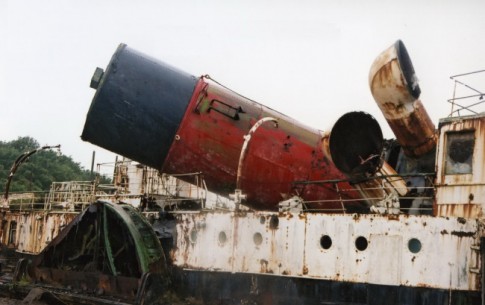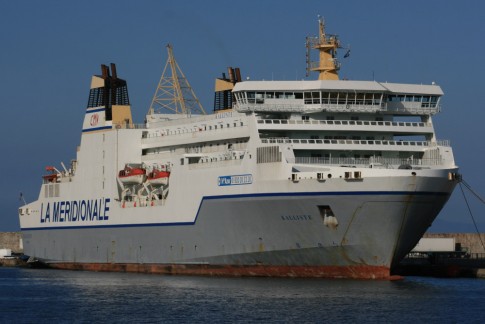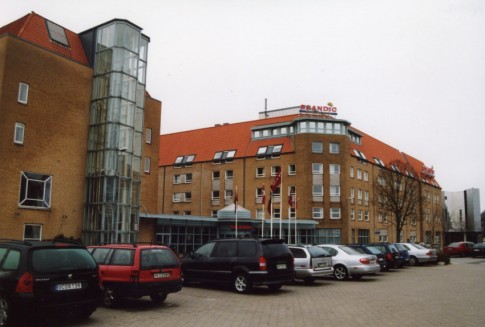
Thereafter, the ships have had interestingly varied careers, all three surviving into the new century before the ex-Surrey was scrapped in 2005. This vessel had in between times been converted to a passenger ferry by A K Ventouris, under whom, as the Anna V, she was mysteriously sunk by a bomb in Patras harbour. Repaired, she saw sparing further service as the Jupiter, being laid up for a prolonged period in Brindisi and then Elefsis before sailing for scrap as the Pit.

The Surrey’s earlier sister ships have both met slightly happier fates, although the future now looks uncertain in each case. The Somerset of 1966 became a livestock carrier but this picture from July last year shows her in a very poor condition. Her AIS is still on however and she is currently listed as sailing through Greek waters. On Ships Nostalgia (registration required) there is an astonishing picture of the ship, as the Afroditi, aground near Waterford in the 1980s with huge piles of hay on her after decks.

The Stafford (1967) was quite horrifically converted first into a Greek passenger/car ferry (named the Voyager and then the Monaco) and then into a cruise ship for operation out of Miami. She is seen here in her Voyager guise in the mid-1980s and, following her return to Greek waters, as the cruise ship Atlantis at Santorini in the early 2000s. Subsequently sold to American owners, the ship has been laid up for some time in Elefsis, latterly Elefsis Bay.
Despite this, she shares top billing on her owners’ enthusiastic website with the Casino Royale, originally HML’s famed second purpose-built car ferry the Castalia. A press release from January 2010 notes that the company is “currently evaluating port locations in East Asia and the United States for the establishment of its initial operations… Each vessel is anticipated to have a capacity of approximately 1,200 passengers and will offer the Company’s patrons a full entertainment experience. Upon completion of the intended renovations, the shipboard entertainment venues on the m/v Casino Royale will include a 100 seat full service gourmet restaurant, a 300 seat buffet restaurant, a casino, a sports bar, a VIP lounge, and a covered outdoor entertainment deck, while the m/v Island Breeze will offer a 100 seat full service gourmet restaurant, a 300 seat buffet restaurant, a casino, a sports bar, a high energy nightclub, a VIP lounge, and a 400 seat showroom. ”

Sticking with the website’s title ships, here is an unusual image of the Vortigern, near the end of her UK career, at Dieppe.
Lastly the Hengist and perhaps her most famous moment, the grounding off the Warren in 1987, was captured on video. Meanwhile, the ship’s current operators, Ventouris Sea Lines, at last have a proper website, complete with a good selection of on board images of the most carefully maintained veteran ferry sailing in Greek waters.
First up, Piraeus (and surrounding areas) in 1968.
Some extracts from a 1970s film which highlights some of the quayside structures, including the long gone passenger walkways.
In Piraeus port 1995, a cast of dozens of classic ships line up for the camera – this was before the demise of Ventouris Sea Lines later that year and the Apollo Express 2 is seen in operation, whilst the Milos Express (Vortigern) is seen just out of refit.
And lastly the brief but strangely mesmerising Classic ferries of Greece
At the end of the latter film comes footage of the Sappho (ex-Spero) and scenes aboard this ship feature heavily in these extracts from a 1970s film. It is readily apparent that her interiors were almost completely unchanged, right down to the large map of the North Sea adjacent to the information desk. Some more on board video can be found here (from about 3:25 in & turn the sound DOWN!).

Part One
Part Two
Part Three
The ship sank twice – the first time was during the Second World War when she was scuttled in Paradiso Bay, just north of Messina, the day before Sicily fell to the Allies in August 1943. She remained submerged for six and a half years before being raised, rebuilt and restored to service in 1953. Finally retired after a 59-year career, she was sold to the local authority in Messina and intended to become a maritime museum. Neglected and abandoned, she sank for a second and final time in 2006.
This link, from the Internet Archive, documents the ship’s career and dates to before her 2006 sinking but prophetically notes that “neglect, incompetence, disinterest and abandonment are pulling the Cariddi down again.”
A more complete history of this route, one of the outstanding ferry experiences in Europe, can be found here.
The website notes that the Wahine’s foremast has recently been placed in position as a monument on the rocks near to where survivors came ashore on the morning of the disaster.

Quelle horreur!

The Sud Express was established in 1887 and ran through to Lisbon from Paris and Calais (later it was just Paris to Lisbon and later still Paris to Hendaye/Irun, change trains, and then Hendaye to Lisbon). Alas, it’s not just a case of “another one bites the dust??? – this truly was the last of the great loco-hauled Grand European Expresses. The Sud outlasted the remnants of the (real) Orient Express by a couple of years. The Nord Express, the Train Bleu, the Peninsular Express, the Oberland Express etc all fell by the wayside long ago. The relevance of these long-distance luxury train connections to the ferry industry died out decades ago with the onset of mass air travel, but the train/ship/train link was before then vital for anyone who wanted to travel significant distances in Europe.
And just how useful would the Paris/Oostende-Oslo cars of the Nord Express (via the Nyborg-Korsør and Helsingør-Helsingborg train ferries) be today for ash-bound Continental shipowners wishing to get to the Shippax conference starting on the Color Magic on Tuesday…?
Please send any contributions for ‘Things Seen’ to admin@hhvferry.com.

Hi!
Thanks for the informative article, I really enjoyed reading up on ferry history, it was interesting. I’ve actually seen the Ugo Foscolo in Zakynthos, it’s really cool. From this article I’ve gotten some ideas for travelling around Europe.
Thanks,
Mark